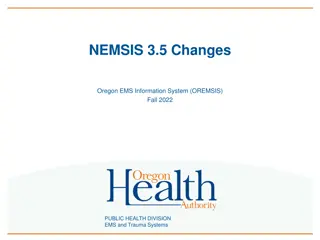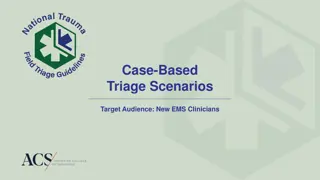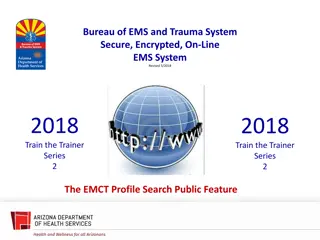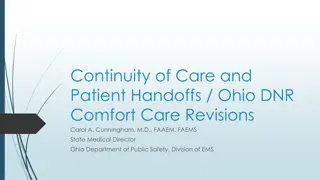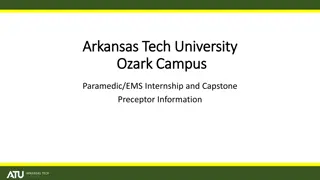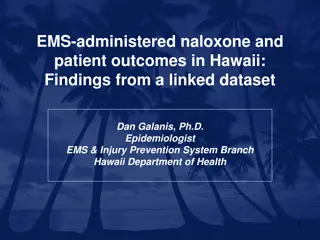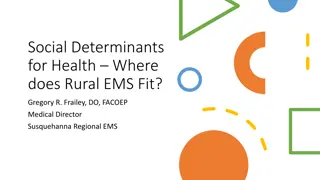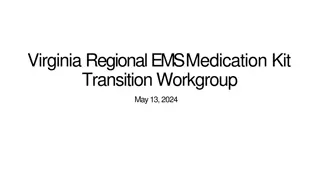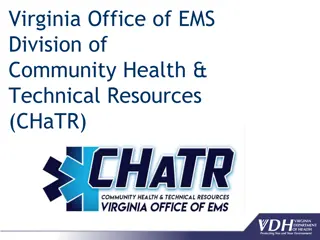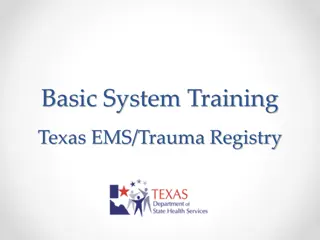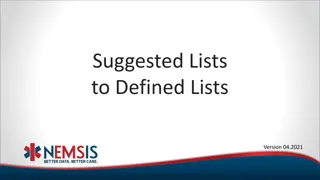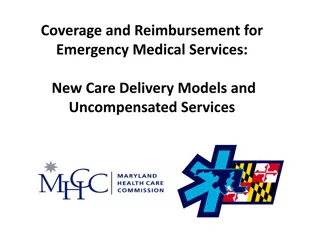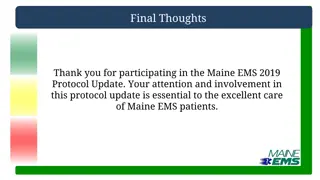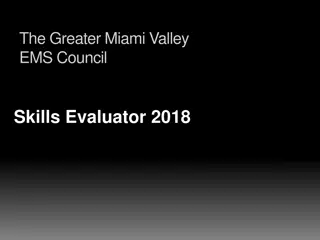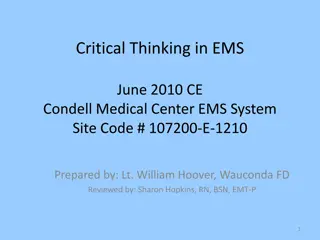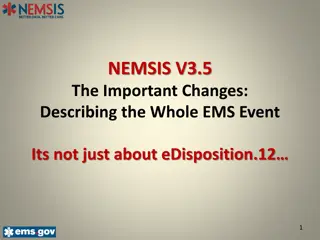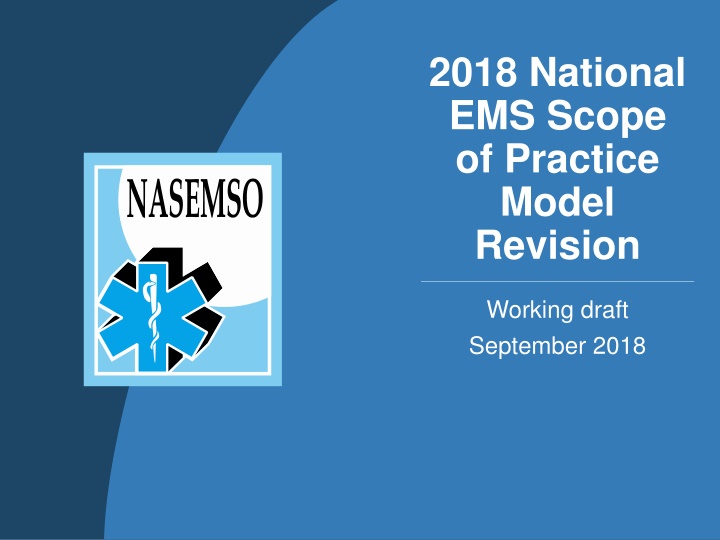
National EMS Scope of Practice Model 2018 Revision
The National EMS Scope of Practice Model 2018 Revision provides an overview of the scope of practice for different levels of EMS personnel, including Emergency Medical Responder, Emergency Medical Technician, Advanced EMT, and Paramedic. It emphasizes the importance of consistency in state regulations, national accreditation for paramedic education programs, and national certification for EMS providers.
Download Presentation

Please find below an Image/Link to download the presentation.
The content on the website is provided AS IS for your information and personal use only. It may not be sold, licensed, or shared on other websites without obtaining consent from the author. If you encounter any issues during the download, it is possible that the publisher has removed the file from their server.
You are allowed to download the files provided on this website for personal or commercial use, subject to the condition that they are used lawfully. All files are the property of their respective owners.
The content on the website is provided AS IS for your information and personal use only. It may not be sold, licensed, or shared on other websites without obtaining consent from the author.
E N D
Presentation Transcript
2018 National EMS Scope of Practice Model Revision Working draft September 2018
DISCLAIMER A final draft was delivered to NHTSA on June 22, 2018. The document remains in agency review and has not been approved as final. Publication is anticipated in the Fall 2018.
The EMS Education Agenda for the Future: A Systems Approach National EMS Core Content The Universe of EMS Knowledge and Skills National EMS Scope of Practice Delineation of provider practice levels Replaces the National Standard Curricula National EMS Education Standards National EMS Education Program Accreditation National EMS Certification
NASEM Calls for Consistency: 2006 Emergency Medical Services At the Crossroads 4.1: State governments should adopt a common scope of practice for EMS personnel 4.2: States should require national accreditation for paramedic education programs 4.3: States should accept national certification as a prerequisite for state licensure and local credentialing of EMS providers.
National EMS Scope of Practice Defines the national licensure levels of EMS personnel Is a model for states to follow in defining what EMS professionals can do NASEMSO-led effort 1st Edition Released in 2007 Project funded by NHTSA and EMSC
Four National Levels of EMS Personnel: Emergency Medical Responder (EMR) Emergency Medical Technician (EMT) Advanced EMT (AEMT) Paramedic
2017 SoPM Subject Matter Expert Panel
Objectives of 2018 SoPM Revision Identify new evidence and science regarding the regulation and State licensure of EMS personnel Facilitate implementation of the Scope Model with State EMS regulators including medical directors Provide opportunities for broad public and EMS community input and participation Incorporate new evidence and science as well as public and EMS community input into the document Improve the consistency and uniformity of EMS throughout the nation while still honoring the unique needs of individual states
SOPM Defines: Minimum practice requirements in advance of gaining field experience and prior to supervised or individual work experience. It is not intended to define the limits of EMS practice. Scope of practice that exceeds the National Model is based on community needs and defined in a collaborative manner by the state and the medical director.
NHTSA Change Notice 1.0 Administration of Narcotic Antagonists Use of narcotic antagonist at all levels EMR and EMT: unit-dose, premeasured, intranasal, or autoinjector Published November 2017 at https://www.ems.gov/pdf/2007-National-EMS- Scope-of-Practice-Mode-Cover-Letter-and- Change-Notices.pdf
NHTSA Change Notice 2.0 Hemorrhage Control Use of tourniquets at all levels Use of wound packing at all levels Published November 2017 at https://www.ems.gov/pdf/2007-National-EMS- Scope-of-Practice-Mode-Cover-Letter-and- Change-Notices.pdf
Determining Medical Appropriateness Is there evidence that the procedure or skill is beneficial to public health? What is the clinical evidence that the new skill or technique as used by EMS practitioners will promote access to quality healthcare or improve patient outcomes? (The base of evidence should include the best available clinical evidence, clinical expertise, and research.)
Systematic Reviews Use of Narcotic Antagonists Hemorrhage Control in Trauma Therapeutic Hypothermia in Cardiac Arrest CPAP/BiPAP Pharmacological Pain Management
The Interdependent Relationship Between Education, Certification, Licensure, and Credentialing
Increasing Depth and Breadth Paramedic Level AEMT Level Depth EMT Level EMR Level Breadth
Special Topics Considered Liability in Licensing and Oversight Special Populations Care During Disasters, PHE, and Extraordinary Circumstances Non-traditional Roles Specialty Care Military to Civilian Transitions Nomenclature Academic Degree Requirements for Paramedics Attendant Qualifications for Ambulance Transport Portable Technologies
Extensive Discussions on Floor vs Ceiling Such as: Blood glucose monitoring at EMR level Pulse oximeters at EMR level Supraglottic airways at EMT level Waveform capnography at EMT level Use of vial/syringe by EMTs Assisting patient with own prescribed medications at BLS levels
Deletions Military AntiShock Trousers (MAST)/Pneumatic AntiShock Garment (PASG) Spinal immobilization (this terminology has been revised) Demand valves Carotid massage Automated transport ventilators at the EMT level (deferred to a decision by the medical director) Modified jaw thrust for trauma Assisting patient with own prescribed medications
Additions - EMR Administration of narcotic antagonists Hemorrhage control (tourniquets and wound packing) Spinal motion restriction using cervical collars and basic splinting for suspected extremity fractures
Additions - EMT Administration of narcotic antagonists Hemorrhage control (tourniquets and wound packing) Administration of beta agonists and anticholinergics Oral over-the-counter (OTC) analgesics for pain or fever Blood glucose monitoring Continuous positive airway pressure devices (CPAP) Pulse oximetry Telemetric monitoring devices and transmission of clinical data, including video data
Additions EMT (contd.) The Expert Panel also agrees that there will be instances of lower level personnel providing assistance to higher levels assisting with skills of the high-level personnel when: the higher-level personnel does the key portion of the procedure, and the assistance is authorized by the medical director, and the assistance is in the direct presence and supervision of the higher-level personnel, and the assistance is permitted by the State.
Additions - AEMT Monitoring and interpretation of waveform capnography, Additional intravenous medications (such as epinephrine during cardiac arrest and ondansetron), and Parenteral analgesia for pain
Additions - Paramedic High-flow nasal cannula Expanded use of OTC medications
Immunizations The psychomotor skill related to the administration of immunizations as an intramuscular injection has been acknowledged by the Expert Panel in the Interpretive Guidelines. Immunizations are medications that require a prescription. Appropriate education related to immunizations is required. Credentialing by the EMS medical director is required. States retain the authority to determine the role and utilization of EMS personnel in immunization programs.
For more information: Kathy Robinson, Project Manager robinson@nasemso.org Ph: 703-538-1799 ext 1894 Dan Manz, Project Consultant manz@nasemso.org

